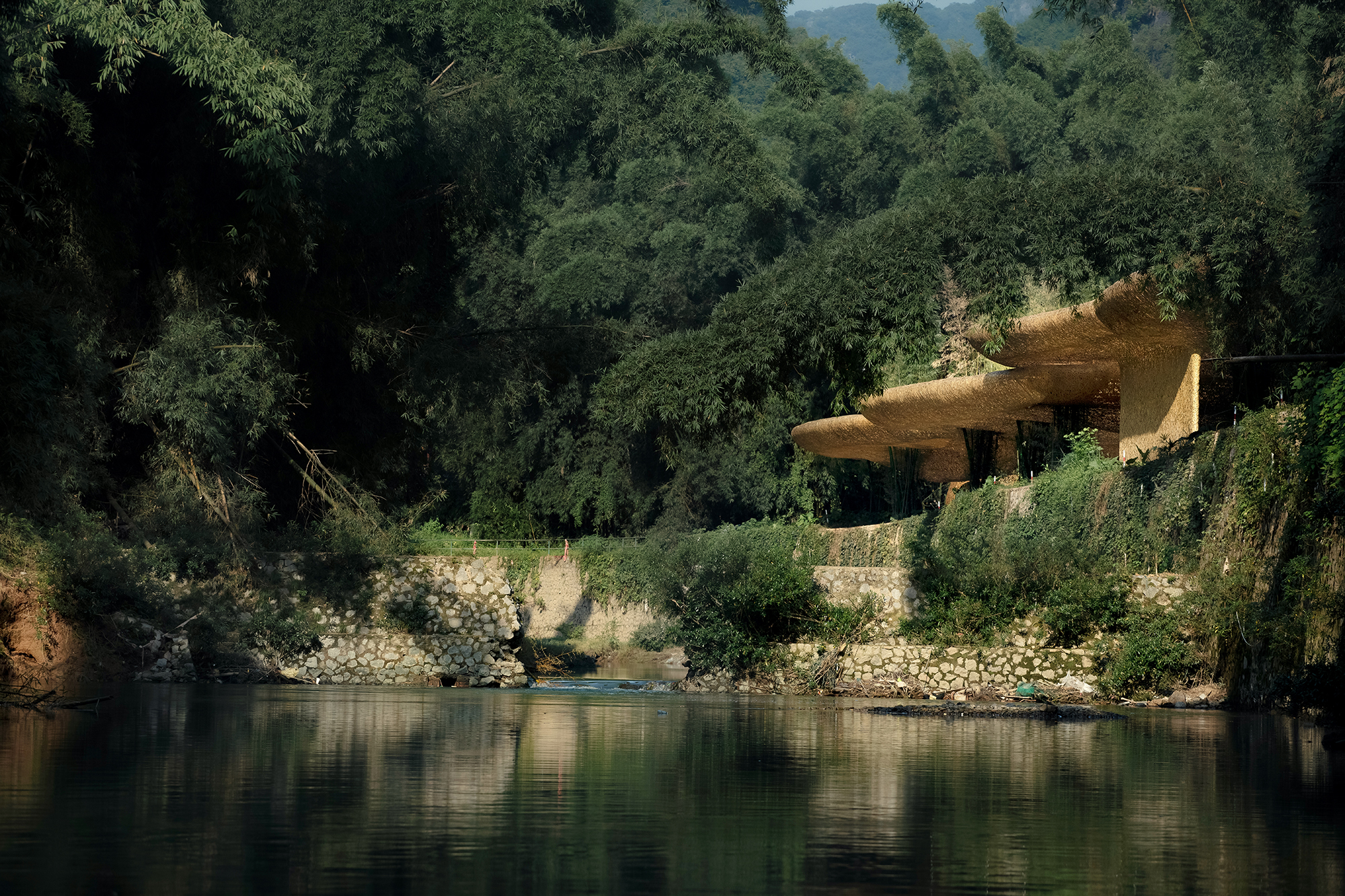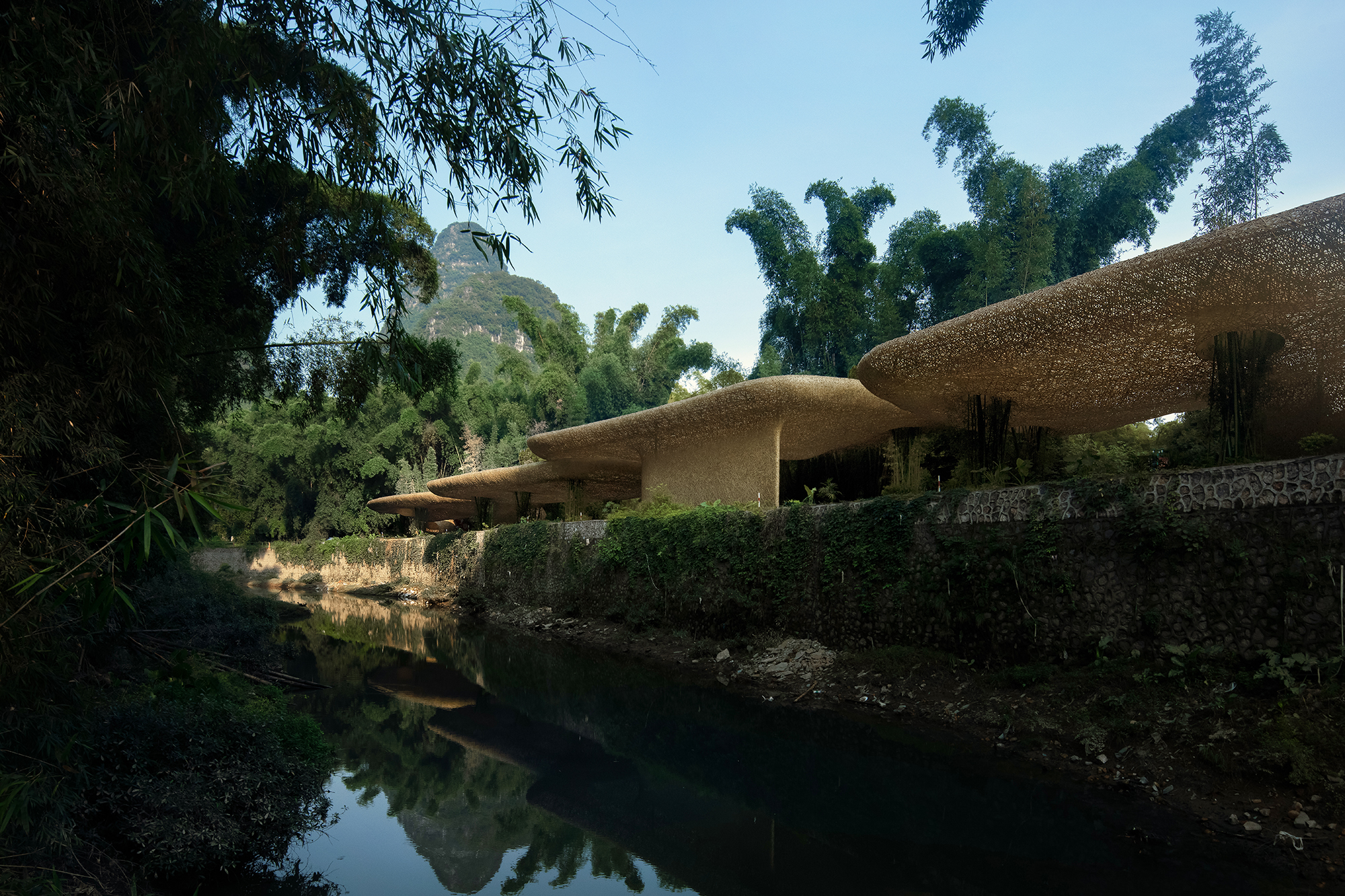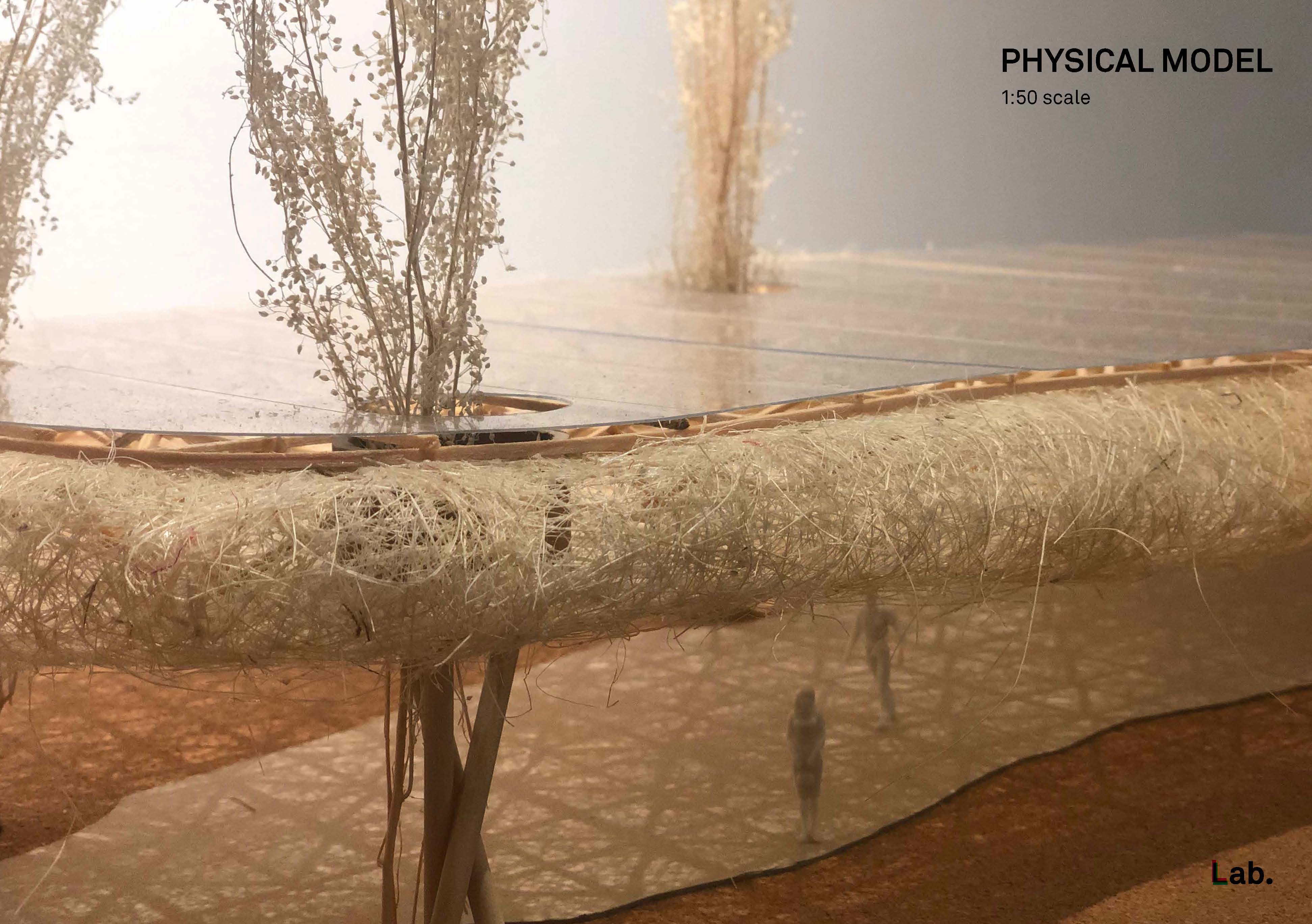
设计单位 叙向建筑设计
项目地点 广西桂林
建筑面积 1900平方米
建成时间 2020年7月
世人皆知桂林山水甲天下。项目位于阳朔印象刘三姐园区,是中国极具戏剧性的自然景观之一。无尽的绿植环绕着巨大的山丘与岩石,面对如此宏伟的景观地貌,任何不协调的对抗式的设计手法都变得不再合理。基于对于现场的这种理解,自然元素本身即成为这次建筑概念设计的前提,而竹子在这次的设计中更为突出。
The Impression Sanjie Liu, Yangshuo, Guilin is located in one of the most dramatic landscapes in China. Endless greenery surrounds the site filling space between large karst towers of rock. With a landscape so grand any moves to dismiss it, let alone compete would make little sense. With this understanding it was decided that the natural elements themselves would form the premise for what architecture would inhabit the site, one element in particular, bamboo.


印象刘三姐园区的演出,已经运营有15年的时间了。参考本地景观的状态后,设计师对于项目的出发点提出了一种想法:维持大多数现有结构不变,将设计和规划的重点转移到采用一种可以维护现有景观的同时,更加突出本地自然之美的干预手法。
The Impression Sanjie Liu is already well established, now in its 15th year of operation. The project presented a situation where most existing structures would remain untouched. Instead focus shifted to how introducing new intervention could support a pre-existing condition.


目前,大部分地区都覆有大片竹子,形成了竹林绿道长廊的结构。为了与场地已有的方式相吻合,新建筑借用竹子的生长习性和其生长过程中形成的空间形态,将其重新配置,并形成新的空间。
At present, large clusters of bamboo cover most of the site, creating structures of mingling pipes and leaves. As a means to coincide with what is already there, the new architecture looked at borrowing the materiality of the bamboo, reconfiguring it to form new space.


这样的设计和实施策略,使新形成的空间不会与现有的自然环境相互竞争,同时起着呼应与强化的效果。尽管使用了自然的手法,达到最佳效果需要相对较长的时间,但这个过程反而更能体现出可生长的设计策略中蕴含的力量,同时增强了感受者与周围的竹林及丘陵的互动感和意识感。
In doing so, this new space means not to contest. Instead it aims to augment, albeit very gently, the surrounding bamboo groves and hills.


印象刘三姐的演出在天黑后开始,观众和园区的拜访者主要集中在园区岛屿的两端,起始点为园区的主入口,即宾客到达的入口和原鼓楼区域(现为修缮后的印象刘三姐文化博物馆);另一端,也就是演出舞台及观众席,则位于园区最深处的漓江岸边。而两端间的占据园区大部分区域的空间,却仅用作交通的区域,完全没有连接性的文化内容来帮助访客获得更有意义的体验。正是在这个中间模棱两可的空间里,项目引入了两个新的体系,在融合入现有的自然肌理的同时,形成一种情绪感知及故事文化的铺垫过程。
Currently, the night show entertains guests in two areas, one at either end of the island site. The entry and pagoda where guests arrive, and the main stage, perched at the bank of the Li river at the other end. Between these two points little interaction takes place. It is here in this middle ground that two new assemblies of architecture are introduced.


第一个体系“竹灯未央”, 即手工竹编制成的灯笼结构空间,散落分布在访客入场流线的区域,作为入场前感受刘三姐文化的体验、文创销售和休憩的空间。
The first, woven bamboo lantern structures, scattered where guests circulate, whose purpose is to guide and intrigue.
另一个体系“手工竹艺长廊”, 在竹丛之间形成一层手工编织的高低错落的“竹网”,提供了可以避开常规降雨的步行区域。
Then the other, a stretch of woven canopy amongst clusters of bamboo, providing area to walk sheltered from regular rainfall.

这两个体系的创建和形成,不仅作为它们本身存在的属性,还是它们与周围自然环境的材料、肢体和感受上的一种内外的共鸣与呼应,则更是不断传递着层层更新的意义,相互赋予出更强的生命力。
In these, the architecture relies on bamboo not only for its composition, but also its constant referral to parts that constitutes the place.

竹灯未央
刚入园区时,沿着通往演出场地的通道,体型较小的竹灯会发出斑驳的光线信号。随着访客进一步向园区深处走去,将会发现原本视野中“竹灯”的体量变得越来越大,以至可以成为供人使用的空间。视觉产生了体量错觉,到察觉到这个错觉,再到体量变化带来的物品与空间上的感受变化,原本仅用作流线的行走通道则因此变得有趣,不再因为功能和行为上的单一性带来感受上的单调。
When entering the site, lanterns small in stature line along the pathway cast out signals of dappled light. As visitors travel further the once small lanterns become drastically larger to a point where the guests can find themselves able to walk inside.


竹灯的妆容是真诚的,内外两侧都为手工切割成的竹条,绑扎包裹着天然竹杆自然找形形成的结构。从微观视角观察细节,人们可以感觉到只有在真正手工制作的条件下,才能创造出的随机美感。
The makeup of the lanterns remains sincere, with a structure of bamboo lengths encased in lashed bamboo either side. On closer inspection one can get a sense of the random beauty that can only be created when something is truly constructed by hand.


竹灯的外侧编织层在感官上会略显深暗,真实地反映了经火烧加热形成弯曲轮廓时留下的自然印迹。基于此工艺,当地的工匠团队以随机的方式将无数竹条相互穿插、缠绕,不使用任何胶水或钉子来保持形状和纹理,完全自然地以此方式寻找着最真实的光线穿透效果。这种生产方法展示了错综复杂却最合理真实的创造方式,工匠们的手法及其潜意识中对材料的深刻理解塑造出了竹灯的美感。
The slightly dark appearance of bamboo framing shows markings of how it is bowed with fire to create the curved lantern silhouette. Over this, piece by piece, teams of local craftsman have threaded numerous stripes of bamboo in an unintentional pattern that requires no glues or nails to hold its shape. This method of production is a showcase of intricacy, clearly shaped by the hands of people and their intuition of beauty.


在日光下,竹灯的外形显得相对坚实,外壳的黄色与环境的绿色相辅相成。夜幕降临,竹灯的个性从空间性的体态转变为多孔且更加通透的形式。竹灯本身成为光的散射体,与访客一起玩起了视觉空间与光线不断变幻的游戏。
In the daylight, the lanterns appear solid, the yellow of the shell in compliment with the green surrounding. Come night the personality of the lantern shifts from something more unyielding to a porous shell. The lantern itself is a diffuser of light, playing theatrics of scale and light with guests.

从整体上看,竹灯的概念取之于园区竹丛在空中交错而形成的拱形门洞的形态。然而,几乎是一种偶然,仰望远处,阳朔的自然山石也呼应了竹灯的轮廓,桂林的风景就沿着眼前的地平线散开。
As a whole, the lantern looks at home under the arching towers of bamboo in its peripheries. Almost by chance, when looking to the distance the lantern silhouette is echoed by the stone towers of the Yangshuo, Guilin landscape strewn along the immediate horizon.


手工竹艺长廊
沿着岛的边缘伸展,“手工竹艺长廊”的竹棚飘浮在错落而至的竹丛之间,乍一看,它似乎没有依靠的结构支撑,只有竹丛穿过竹棚圆形的开口空间向上生长。实际上,隐藏其中的如竹子般粗细的结构柱,则从其立足点开始向上、向外地旋转、扭曲,宛如竹子的生长般,也长入圆形的开口空间并与竹棚内部的结构相连。
Further along at the edge of the island, the canopy shrouds itself within the large masts of bamboo. At first glance it appears to rely on little for support, only the columns of bamboo shooting up and through circular openings. Hidden amongst these living clusters columns twist from their footing upward and outward mimicking the indecisive route of the bamboo to meet the structure above. Supported by the columns in a maze of tubes, the structure of the canopy while seen doesn’t look out of place.


“手工竹艺长廊”的竹条编织表面从入口的位置延伸出140余米,呈倒置景观的形状,以不同的幅度上下起伏。同时,竹棚表面采用与竹灯相同的不规则手工编织竹条制作而成,看起来宛如幻想中的空间体验,顺着竹体波浪飘向空间的深处。原本枯燥的等待体验变得沉浸又虚幻,再次将访客的感观扩展到整个自然环境的氛围中去。
The hand-woven layer obscures what is in front and what lays behind. Stretching 140m from where you stand the woven ceiling takes on a shape of an inverted landscape, undulating between different levels of surfaces. The stepping surface of the canopy is pieced together entirely in the same irregular hand-woven bamboo as the lantern, but on a scale that seems that it should be seated in fantasy. The resulting intention means to enchant while still extending recognition to the natural condition of the site.




光线穿透竹编波浪,将斑驳的光点散布到地面上。当在竹棚下行走时,光线通过竹棚散射开,均匀地照亮整个空间,但当抬头仰望时,却能收获意想不到的视觉体验,整个顶篷散发出温和的金色光芒。
Under daylight, light streams through to the woven canopy bringing patches of dappled light to the ground below. While reprieve from the sun is apparent when walking underneath, in an unexpected compliment when looking up the ceiling appears illuminated, the entire canopy giving off a temperate glow.



夜色降临,竹棚内的人造灯光的光线通过竹网的缝隙,将光更有戏剧性、更专注地照向地面,顶底两层光波的实虚包夹,让体验变得更为充实。
In the transition to night, introduced light within the volume rises in intensity focusing the spattering of light in a more vivid pattern on the pathway. Fragments of bodies dip in and out view as light streams down through the ceiling above onto guests making their way the stage.


对刘三姐印象的戏剧精神的认可及对当地自然环境的感动和尊敬,令设计师将诸多可感知的元素,潜移默化地穿插进了设计的多个部分:手工编织文化的融入、与自然环境相融合的竹条、竹丛立柱之间的舞动着的竹棚起伏的倒置地形、与竹子生长形态相呼应的结构柱的体态,甚至在叙事性的流线及互动情境中,访客从竹灯移到另一个空间的方式……这些微妙的细节提示共同激发了特定的意识感知框架,为访客观看演出带来了最好的心理和文化上的铺垫。
In acknowledgment to the theatrical spirit of the Impression Sanjie Liu, moments of performance make its way into many parts of the design: The hand weaving, bamboo playing off the tension of one another. The topography of the canopy ceiling dancing between columns of bamboo as if unsupported. Even the way guests are intended to move from lantern to lantern, in a narrative of interaction. Together these subtle hints encourage a particular frame of mind, readying the guest for the main feature.


完整项目信息
项目名称:竹林亭台楼阁
项目地点:广西壮族自治区桂林市阳朔县印象刘三姐园区
场地面积:9万平方米
建筑面积:1900平方米
项目状态:已完工
项目时间:2018年5月—2020年7月
项目客户:桂林大型山水实景演出《印象·刘三姐》
设计单位:叙向建筑设计
建筑设计:刘涵晓、Henry D'Ath、胡乐贤、Alyssa Tang、范超然、Luis Ricardo、David Correa
项目管理团队:玻陶铂丝(上海)建设工程有限公司、密李华、柴大林、张浩、万国阳
项目建设团队:邵应宏、董艳茹、邵应明
结构设计:栾栌构造设计事务所
摄影:存在建筑-建筑摄影
版权声明:本文由叙向建筑设计授权发布,欢迎转发,禁止以有方编辑版本转载。
投稿邮箱:media@archiposition.com
上一篇:金茂资本 J SPACE:太空漫游 / DAGA大观建筑
下一篇:OMA新作:图卢兹会展中心MEETT,横跨700米的长条体量